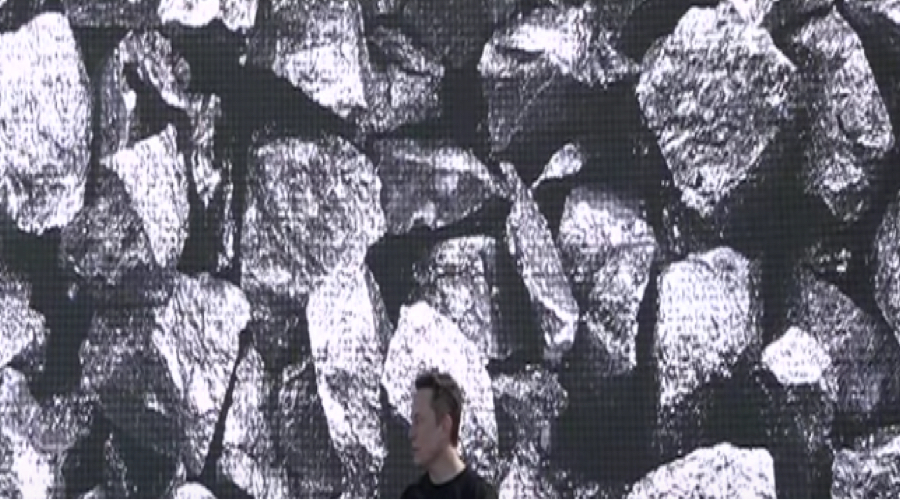Global S&T Development Trend Analysis Platform of Resources and Environment
| Mines are the biggest holes in Tesla’s $25,000 car plans | |
| admin | |
| 2020-09-24 | |
| 发布年 | 2020 |
| 语种 | 英语 |
| 国家 | 国际 |
| 领域 | 地球科学 |
| 正文(英文) |  Tesla CEO Elon Musk speaks at Battery Day 2020. Via YouTube.
During Tuesday’s much-hyped battery day, Tesla CEO Elon Musk laid out plans to put everyone behind the wheel (or is that sleeping in the back) of a $25,000 car that drives itself. Much of the three hour-plus presentation was low on detail, high on promotion and stratospheric on ambition, (it is ever thus) but Tesla’s plans to start mining seemed particularly simplistic. With great fanfare and 40 years after Chevron’s Thacker Pass, Tesla announced to the world – and to a parking lot – that there were significant untapped lithium reserves in Nevada clay.
Tesla said they secured the rights to 10,000 acres in the Silver State but if their factory was in Hawaii they probably would’ve mined there, because as Musk told the cars assembled in front of the stage “it’s pretty much everywhere”:
Yes. It is crazy. Lithium. Now widely availableMusk went on to explain there is enough lithium in the United States to convert the entire vehicle fleet in the US to electric. Enthusiastic honking from the lot. Musk was later corrected by his SVP on stage that actually the lithium in Nevada alone is sufficient to electrify the 300 million US car parc. Moreover, that’s lithium already been “discovered today” to which Musk appended:
There are 63kgs of lithium carbonate in a Tesla 70kWh battery. So that’s 18.9 million tonnes if everyone wants to trade in their clunker for a Model Y. Global lithium carbonate equivalent production last year was 365,000 tonnes, an increase of 32% from the year before. Just 32%? Clearly the lithium mining industry simply hasn’t even been trying. Salting away
Musk solves difficult problems from a “first principle standpoint” which he frequently referred to on stage. Invented by Aristotle and evidently perfected by Musk, this approach basically says forget about how things have always been done. Think like you’re the first one looking for answers to solve a particular problem. The question, according to Musk:
The solution, according to Musk:
Add table salt. Add water. A recipe for lithium mining. With extraction solved, how about tailings? Again, first principle thinking will provide the answer:
Honk. Honk. Honk. Bookshelf
Cobalt hardly got a mention in the session, except in the bit about how a cathode is like a bookshelf with cobalt being the “stable” part of said bookshelf. If they really wanted to put it into layman’s terms they could just have said cobalt stops our cars from bursting into flames. “Leveraging novel coatings and dopants,” is how Tesla says it successfully eliminated cobalt altogether, which is not the first time Musk has leveraged dopants either. Did Tesla join the Congo artisanal cobalt support group this month? Yes. Why? No reason. Did Tesla sign a long term supply agreement with Glencore for cobalt from the Congo in June? Yes. Why? No reason. Honk. Honk. Out comes the batteryWith lithium mining sorted, cobalt gone and graphite replaced by “awesome and inexpensive” sand (it’s not called Silicon Valley for nothing), Musk moved onto nickel. Tesla will need the devil’s copper in spades (in spades, not in HPAL) as it motors towards nickel rich batteries and annual production of 20 million cars a year.
Think 20m is too ambitious? You must not be using first principle thinking, because all you really need to do is eliminate “legacy things” like metal sulfates from the process. Eliminating this “insane” step – which “just happened to be what chemists wanted a long time ago” – you end up with this:
Even so, Musk worries that Tesla won’t be able to scale and “we have to make sure we are not constrained by nickel availability”:
You’re right, Elon, miners are making more nickel as I write this. Just get on the horn again when you need them to make more. Honk.
|
| URL | 查看原文 |
| 来源平台 | Minging.com |
| 文献类型 | 新闻 |
| 条目标识符 | http://119.78.100.173/C666/handle/2XK7JSWQ/296535 |
| 专题 | 地球科学 |
| 推荐引用方式 GB/T 7714 | admin. Mines are the biggest holes in Tesla’s $25,000 car plans. 2020. |
| 条目包含的文件 | 条目无相关文件。 | |||||
| 个性服务 |
| 推荐该条目 |
| 保存到收藏夹 |
| 查看访问统计 |
| 导出为Endnote文件 |
| 谷歌学术 |
| 谷歌学术中相似的文章 |
| [admin]的文章 |
| 百度学术 |
| 百度学术中相似的文章 |
| [admin]的文章 |
| 必应学术 |
| 必应学术中相似的文章 |
| [admin]的文章 |
| 相关权益政策 |
| 暂无数据 |
| 收藏/分享 |
除非特别说明,本系统中所有内容都受版权保护,并保留所有权利。
修改评论